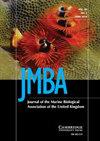Influence of environmental factors on biodiversity, abundance and the distribution pattern of dinoflagellates and ciliates during spring and summer in coastal waters of Algeria (southwestern Mediterranean Sea)
IF 0.9
4区 生物学
Q3 MARINE & FRESHWATER BIOLOGY
Journal of the Marine Biological Association of the United Kingdom
Pub Date : 2023-07-18
DOI:10.1017/S0025315423000371
引用次数: 0
Abstract
Abstract The objective of this study was to assess the distribution patterns of dinoflagellates and ciliates communities during planktonic bloom and post-bloom development periods, in relation to environmental parameters. Their distribution was studied during spring and summer 2012, in coastal waters of Algeria at six sampling stations (four sampling layers). Overall, 116 species were identified, including 98 dinoflagellates. The species richness of microzooplankton was higher in summer (81 species: 67 dinoflagellates, seven tintinnids and seven ciliates) than in spring (76 species: 72 dinoflagellates, three naked ciliates and one tintinnid). Significant difference in total abundances was observed between spring (median = 145 ind l−1) and summer (median = 90 ind l−1) but no significance (P > 0.05, Mann–Whitney test) in Shannon–Wiener (H′spring: 3.31 bits ind−1; H′summer: 3.70 bits ind−1) and evenness (Espring: 0.77; Esummer: 0.84) indices. The ciliate average abundance was higher in summer (11.3 ind l−1) than in spring (1.95 ind l−1), whereas dinoflagellate average abundance was lower in summer (127.92 ind l−1) than spring (190.19 ind l−1). Non-metric multidimensional scaling was used to identify different sample assemblages. It showed that temperature and salinity influenced the distribution pattern in the canonical correspondence analysis followed by chlorophyll a, silicate and nitrate concentrations. Our framework provides insight regarding trait trade off with implications for feedbacks to ecosystems, aiming to bridge the gap of plankton community ecology in Algeria. It elaborates a taxonomic list of dinoflagellates and ciliates in the marine pelagic ecosystem and performs their ecological characterization in their environment.环境因子对阿尔及利亚(地中海西南部)沿海春夏季甲藻和纤毛虫生物多样性、丰度及分布格局的影响
摘要本研究的目的是评估甲藻和纤毛虫群落在浮游水华和水华后发育期的分布模式与环境参数的关系。2012年春季和夏季,在阿尔及利亚沿海水域的六个采样站(四个采样层)研究了它们的分布。总共鉴定了116种,其中包括98种甲藻。夏季微型浮游动物的物种丰富度(81种:67种甲藻、7种丁虫和7种纤毛虫)高于春季(76种:72种甲藻,3种裸纤毛虫和1种丁虫)。春季(中位数=145 ind l−1)和夏季(中位数=90 ind l–1)的总丰度存在显著差异,但在Shannon–Wiener(H′春季:3.31位ind−1;H′夏季:3.70位ind–1)和均匀度(Espring:0.77;Essummer:0.84)指数中没有显著差异(P>0.05,Mann–Whitney检验)。夏季纤毛虫的平均丰度(11.3 ind l−1)高于春季(1.95 ind l–1),而甲藻的平均丰度在夏季(127.92 ind l-1)低于春季(190.19 ind l-1)。使用非度量多维标度来识别不同的样本组合。在典型对应分析中,温度和盐度影响分布模式,其次是叶绿素a、硅酸盐和硝酸盐浓度。我们的框架提供了关于特征权衡的见解,并对生态系统的反馈产生了影响,旨在弥合阿尔及利亚浮游生物群落生态学的差距。阐述了海洋浮游生态系统中甲藻和纤毛虫的分类清单,并对其环境进行了生态表征。
本文章由计算机程序翻译,如有差异,请以英文原文为准。
求助全文
约1分钟内获得全文
求助全文
来源期刊
CiteScore
2.30
自引率
8.30%
发文量
68
审稿时长
3-8 weeks
期刊介绍:
JMBA is an international journal, publishing original research on all aspects of marine biology. It includes pioneering work taking place today on major issues concerning marine organisms and their environment. Subjects covered include: ecological surveys and population studies of marine communities; physiology and experimental biology; taxonomy, morphology and life history of marine animals and plants; and chemical and physical oceanographic work. Included with 2010 online subscriptions: Marine Biodiversity Records.

 求助内容:
求助内容: 应助结果提醒方式:
应助结果提醒方式:


